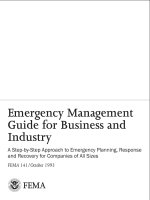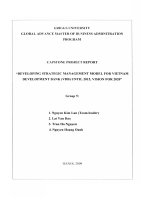Strategic management planing for domestic and global competition 14th john robinson chapter 2
Bạn đang xem bản rút gọn của tài liệu. Xem và tải ngay bản đầy đủ của tài liệu tại đây (267.85 KB, 30 trang )
Chapter 2
Company Mission
© 2015 by McGraw-Hill Education. This is proprietary material solely for authorized instructor use. Not authorized for sale or distribution in any manner. This document may not be copied, scanned, duplicated, forwarded, distributed, or
posted on a website, in whole or part.
Learning Objectives
1.
2.
3.
4.
5.
6.
7.
Describe a company mission and explain its value
Explain why the mission statement should include the company’s basic
product or service, its primary markets, and its principal technology
Explain which goal of a company is most important: survival, profitability, or
growth
Discuss the importance of company philosophy, public image, and company
self-concept to stockholders
Give examples of the newest trends in mission statement components:
customer emphasis, quality, and company vision
Describe the role of a company’s board of directors
Explain agency theory and its value in helping a board of directors improve
corporate governance
2
What is a Company Mission?
•
Company Mission:
A broadly framed but enduring statement of a firm’s intent. It is the unique
purpose that sets a company apart from others of its type and identifies the
scope of its operations in product, market, and technology terms.
3
Questions Addressed in a Mission Statement
•
•
•
•
•
•
Why is this firm in business?
What are our economic goals?
What is our operating philosophy in terms of quality, company image, and self-concept?
What are our core competencies and competitive advantages?
What customers do and can we serve?
How do we view our responsibilities to stockholders, employees, communities,
environment, social issues, and competitors?
4
Formulating a Mission
•
The typical business begins with the beliefs, desires, and aspirations of a single
entrepreneur
•
•
These beliefs are usually the basis for the company’s mission
As the business grows or is forced to alter its product, market, or technology, redefining the
company mission may be necessary
5
Ex. 2.2 (adapted)
•
•
•
•
•
•
•
•
•
•
Mission Statement Components
Customer-market
Product-service
Geographic Domain
Technology
Concern for Survival
Philosophy
Self-concept
Concern for Public Image
Consumers
Quality
6
Ex. 2.2
Excerpts From Actual Mission Statements
7
Ex. 2.2 Excerpts
From Actual Mission Statements (contd.)
8
Three Indispensable Components:
•
•
•
Basic Product or Service
Primary Market
Principal Technology
If a firm uses a “silver bullet” mission for outsiders to read, it will include
these three components.
9
Primary Company Goals
•
Survival – A firm that is unable to survive will be incapable of
satisfying the aims of any of its stakeholders.
– This goal is often taken for granted
– If neglected, firm may focus on short-term aims
10
Primary Company Goals (contd.)
•
Profitability – A firm’s profitability is the mainstay goal of a business.
– Clearest indication of firm’s ability to satisfy principal claims and desires of employees
and stockholders
11
Primary Company Goals (contd.)
•
Growth – A firm’s growth is tied inextricably to its survival and profitability.
Growth in this sense must be broadly defined.
– Important to define growth – i.e., in terms of market share, etc.
12
Company Philosophy
•
•
•
Company philosophy is often called company creed.
Usually accompanies or appears within the mission statement
Reflects the basic beliefs, values, aspirations, and philosophical priorities to
which strategic decision makers are committed in managing the company
13
Public Image
•
Both present and potential customers attribute certain qualities to
particular businesses.
•
Firms seldom address the question of their public image in an
intermittent fashion.
•
Firms should be concerned with their public image even when there is
no public agitation.
14
Company Self-Concept
•
•
•
A major determinant of a firm’s success is the extent to which the firm can relate
functionally to its external environment.
The ability of firms to survive in a dynamic and highly competitive environment would
be severely limited if they did not understand their impact on others or of others on
them.
Ordinarily, descriptions of the company self-concept per se do not appear in mission
statements.
15
Newest Trends in Mission Components
•
Sensitivity to customer wants
– “The customer is our top priority”
– Importance of consumer satisfaction
– Importance of customer service
16
Newest Trends in Mission Components (contd.)
•
Quality
– “Quality is job one!”
– The work of W. Edwards Deming and J.M. Juran
– Malcolm Baldridge Awards
17
Deming’s 14 Points:
1.
2.
3.
4.
5.
6.
7.
Create constancy of purpose.
Adopt the new philosophy.
Cease dependence on mass inspection to achieve quality.
End the practice of awarding business on price tag alone. Instead, minimize total
cost, often accomplished by working with a single supplier.
Improve constantly the system of production and service.
Institute training on the job.
Institute leadership.
18
Deming’s 14 Points (cont’d):
8. Drive out fear.
9. Break down barriers between departments.
10. Eliminate slogans, exhortations, and numerical targets.
11. Eliminate work standards (quotas) and management by objective.
12. Remove barriers that rob workers, engineers, and managers of their right
to pride of workmanship.
13. Institute a vigorous program of education and self-improvement.
14. Put everyone in the company to work to accomplish the transformation.
19
Newest Trends in Mission Components (contd.)
•
A vision statement presents a firm’s strategic intent designed to focus the
energies and resources of the company on achieving a desirable future.
20
Boards of Directors
The board of directors is the group of stockholder
representatives and strategic managers responsible for
overseeing the creation and accomplishment of the company
mission.
21
Major Board Responsibilities:
•
•
•
•
•
•
•
Establish and update mission
Elect top officers & CEO
Establish compensation for top officers
Determine amount & timing of dividends
Set broad company policy
Set objectives and authorize managers to implement long-term strategy
Mandate company’s legal and ethics compliance
22
Agency Theory
Agency theory is a set of ideas on organizational control based on
the belief that the separation of the ownership from
management creates the potential for the wishes of owners to be
ignored.
23
Agency Costs
•
The cost of agency problems plus the cost of actions taken to minimize
agency problems are collectively termed agency costs.
24
How Agency Problems Occur
•
Moral hazard problem
•
Executives are often free to pursue their own interests because of the
disproportionate access they have to company information. This is the moral hazard
problem.
25









